|
|
|
|
|
Oil On
Canvas, Real Flavor of Old Masters
|
|

|
ARTWORKS
INDEX
A B C D E F G H I J K L M N O P Q R S T U V W X Y Z |
ARTISTS
INDEX
A B C D E F G H I J K L M N O P Q R S T U V W X Y Z |
|
|
| | |
|
|
|
|
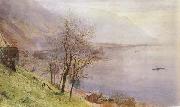 |
John William Inchbold -- Click Here
|
|
1830-1888
English painter. He spent his early years in Leeds, where his father was a newspaper proprietor, but came to London around 1846 to study lithography in the firm of Day & Haghe. His obituary in The Athenaeum records that he went on to study at the Royal Academy Schools, but his name does not appear in the registers. He exhibited watercolours at the Society of British Artists in 1849 and 1850 and at the Royal Academy in 1851. At this period his work has a fluidity and a freedom of handling that is closer to Richard Parkes Bonington than to the prevailing style of Victorian watercolours. Around 1852 he came under the influence of the Pre-Raphaelite movement and radically altered his style. His oil painting of the Chapel, Bolton (exh. RA 1853; Northampton, Cent. Mus. & A.G.) is a meticulously rendered view of the abbey ruins in the Pre-Raphaelite manner. This was followed the next year by At Bolton (Leeds, C.A.G.), another view of Bolton Abbey, this time with a deer prominent in the foreground. Both paintings illustrate lines from William Wordsworth's poem 'The White Doe of Ryleston'. Wordsworth was also the inspiration for the small painting Study in March |
|
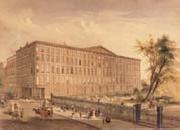 |
John William Hill -- Click Here
|
|
English Painter, 1812-1879,Painter and illustrator, son of John Hill. At the age of seven he moved to Philadelphia, PA, with his family. In 1822 he moved to New York, where he was apprenticed to his father for seven years. During this time, he worked on the aquatint plates for William Guy Wall's Hudson River Portfolio (1821-5), which influenced his early paintings. |
|
 |
John William Godward -- Click Here
|
|
English
1861-1922
Godward was a Victorian Neo-classicist, and therefore a follower in theory of Frederic Leighton. However, he is more closely allied stylistically to Sir Lawrence Alma-Tadema, with whom he shared a penchant for the rendering of Classical architecture, in particular, static landscape features constructed from marble.
The vast majority of Godward's extant images feature women in Classical dress, posed against these landscape features, though there are some semi-nude and fully nude figures included in his oeuvre (a notable example being In The Tepidarium (1913), a title shared with a controversial Alma-Tadema painting of the same subject that resides in the Lady Lever Art Gallery). The titles reflect Godward's source of inspiration: Classical civilisation, most notably that of Ancient Rome (again a subject binding Godward closely to Alma-Tadema artistically), though Ancient Greece sometimes features, thus providing artistic ties, albeit of a more limited extent, with Leighton.
Given that Classical scholarship was more widespread among the potential audience for his paintings during his lifetime than in the present day, meticulous research of detail was important in order to attain a standing as an artist in this genre. Alma-Tadema was, as well as a painter, an archaeologist who attended historical sites and collected artefacts that were later used in his paintings: Godward, too, studied such details as architecture and dress, in order to ensure that his works bore the stamp of authenticity. In addition, Godward painstakingly and meticulously rendered those other important features in his paintings, animal skins (the paintings Noon Day Rest (1910) and A Cool Retreat (1910) contain superb examples of such rendition) and wild flowers (Nerissa (1906), illustrated above, and Summer Flowers (1903) are again excellent examples of this).
The appearance of beautiful women in studied poses in so many of Godward's canvases causes many newcomers to his works to categorise him mistakenly as being Pre-Raphaelite, particularly as his palette is often a vibrantly colourful one. However, the choice of subject matter (ancient civilisation versus, for example, Arthurian legend) is more properly that of the Victorian Neoclassicist: however, it is appropriate to comment that in common with numerous painters contemporary with him, Godward was a 'High Victorian Dreamer', producing beautiful images of a world which, it must be said, was idealised and romanticised, and which in the case of both Godward and Alma-Tadema came to be criticised as a world-view of 'Victorians in togas'. |
|
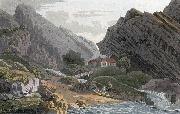 |
John William Edy -- Click Here
|
|
John William Edy (1760 - 1820) was an English painter. He worked for the publisher John Boydell in London, often anonymously. In the summer of 1800 Edy visited Norway on an assignment for Boydell together with the landscape painter William Fearnside. They were in Norway from July 31 and until the end of September the same year.
|
|
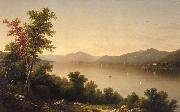 |
John William Casilear -- Click Here
|
|
(June 25, 1811 - August 17, 1893) was an American landscape artist belonging to the Hudson River School.
Casilear was born in New York City. His first professional training was under prominent New York engraver Peter Maverick in the 1820s, then with Asher Durand, himself an engraver at the time. Casilear and Durand became friends, and both worked as engravers in New York through the 1830s.
By the middle 1830s Durand had become interested in landscape painting through his friendship with Thomas Cole. Durand, in turn, drew Casilear's attention to painting. By 1840 Casilear's interest in art was sufficiently strong to accompany Durand, John Frederick Kensett, and artist Thomas P. Rossiter on a European trip during which they sketched scenes, visited art museums, and fostered their interest in painting.
Casilear gradually developed his talent in landscape art, painting in the style that was later to become known as the Hudson River School. By the middle 1850s he had entirely ceased his engraving career in favor of painting full-time. He was elected a full member of the National Academy of Design in 1851, having been an associate member since 1831, and exhibited his works there for over fifty years.
Casilear died in Saratoga Springs, New York in 1893. |
|
 |
John White Alexander -- Click Here
|
|
1865-1915
John White Alexander Galleries
Alexander was born in Allegheny, Pennsylvania, now a part of Pittsburgh, Pennsylvania. Orphaned in infancy, he was reared by his grandparents and at the age of 12 became a telegraph boy in Pittsburgh. His talent at drawing attracted the attention of one of his employers, who assisted him to develop them. He moved to New York at the age of eighteen and worked in an office at Harper's Weekly, where he was an illustrator and political cartoonist at the same time that Abbey, Pennell, Pyle, and other celebrated illustrators labored there. After an apprenticeship of three years, he travelled to Munich for his first formal training. Owing to the lack of funds, he removed to the village of Polling, Bavaria, and worked with Frank Duveneck. They travelled to Venice, where he profited by the advice of Whistler, and then he continued his studies in Florence, the Netherlands, and Paris.
In 1881 he returned to New York and speedily achieved great success in portraiture, numbering among his sitters Oliver Wendell Holmes, John Burroughs, Walt Whitman, Henry G. Marquand, R. A. L. Stevenson, and president McCosh of Princeton University. His first exhibition in the Paris Salon of 1893 was a brilliant success and was followed by his immediate election to the Soci??t?? Nationale des Beaux Arts. Many additional honors were bestowed on him. In 1901 he was named Chevalier of the Legion of Honor, and in 1902 he became a member of the National Academy of Design. He was a member of the American Academy of Arts and Letters. Among the gold medals received by him were those of the Paris Exposition (1900) and the World's Fair at St. Louis (1904).
Many examples of his paintings are on display in museums and public places in the United States and in Europe, including the Metropolitan Museum of Art, the Brooklyn Art Museum, the Los Angeles County Museum of Art, the Museum of Fine Arts, Boston, the Butler Institute, and the Library of Congress in Washington D.C. In addition, in the entrance hall to the Art Museum of the Carnegie Institute in Pittsburgh, a series of Alexander's murals entitled "Apotheosis of Pittsburgh" (1905-1907) covers the walls of the three-storey atrium area.
Alexander was married to Elizabeth Alexander Alexander, to whom he was introduced in part because of their shared last name. Elizabeth was the daughter of James Waddell Alexander, President of the Equitable Life Assurance Society at the time of the Hyde Ball scandal. The Alexanders had one child, the mathematician James Waddell Alexander II.
Alexander's original and highly individual art is based upon a very personal interpretation of humanity. He died in New York. |
|
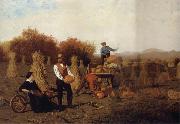 |
John Whetten Ehninger -- Click Here
|
|
American Painter, 1827-1889,American painter and illustrator. After graduating from Columbia College, New York, in 1847, he immediately departed for Europe to pursue artistic training. He visited Italy and France, but staying in Germany, specifically D?sseldorf, was his main objective. There he studied with Karl Friedrich Lessing, Carl Ferdinand Sohn and fellow American Emanuel Leutze, and in Paris he was instructed by Thomas Couture. During the early 1850s he travelled between America and Europe but finally settled in New York in 1853 until his move to Saratoga Springs after marrying in 1877. Ehninger exhibited regularly at the National Academy of Design, New York, where he was elected a full member in 1860. |
|
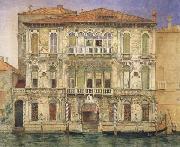 |
John wharlton bunney -- Click Here
|
|
1828-1882
was an English topographical and landscape artist of the nineteenth century. His father was a merchant captain whom Bunney, as a boy, accompanied on several voyages around the world. Bunney demonstrated a strong talent for drawing and draftsmanship from an early age. The young Bunney became a follower of John Ruskin; he studied with Ruskin at the Working Men's College soon after its founding in 1854, and later worked as a clerk for Smith, Elder & Co., Ruskin's publisher. Bunney was able to give up his clerical job and make his living by his art and art teaching by 1859; Ruskin commissioned him to execute a series of drawings in Italy and Switzerland.Bunney married Elizabeth Fallon in 1863. The couple settled in Florence; they would have four children. Bunney worked for Ruskin's St. George's Company (later the Guild of St George) in northern Italy for the remainder of his life. In his career there, Bunney produced a noteworthy pictorial record of Italy in his era. Ruskin said that Bunney's work was "so faithful and careful as almost to enable the spectator to imagine himself on the spot." Bunney was a friend of many of the Pre-Raphaelites, especially William Holman Hunt. From 1870 on, Bunney lived and painted in Venice. In 1876 Ruskin commissioned Bunney to paint a picture that included the entire western facade of St. Mark's Basilica |
|
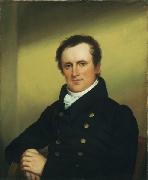 |
John Wesley Jarvis -- Click Here
|
|
(1781 - January 14, 1839), American painter, nephew of Methodist leader John Wesley, was born at South Shields, England, and was taken to the United States at the age of five.
He was one of the earliest American painters to give serious attention to the study of anatomy. He lived at first in Philadelphia, afterwards establishing himself in New York City, where he enjoyed great popularity, though his conviviality and eccentric mode of life affected his work. He visited Baltimore, Charleston, and New Orleans, entertaining much and painting portraits of prominent people, particularly in New Orleans, where General Andrew Jackson was one of his sitters. He had for assistants at different times both Thomas Sully and Henry Inman. He affected singularity in dress and manners, and his mots were the talk of the day. But his work deteriorated, and he died in great poverty in New York City. |
|
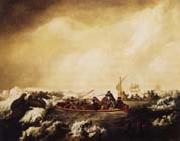 |
John Webber -- Click Here
|
|
(1751-1793), Landscape painter, was an English artist best known for his images of early Alaska and Hawaii. Webber was born on October 6, 1751 in London, educated in Switzerland and studied painting at Paris[2]. Webber served as official artist on Captain James Cook??s third voyage of discovery around the Pacific (1776-1780) aboard HMS Resolution. At Adventure Bay in January 1777 he did drawings of "A Man of Van Diemen's Land" and "A Woman of Van Diemen's Land". He also did many drawings of scenes in New Zealand and the South Sea islands. On this voyage, during which Cook lost his life in a fight in Hawaii, Webber became the first European artist to make contact with Hawaii, then called the Sandwich Islands. He made numerous watercolor landscapes of the islands of Kauai and Hawaii, and also portrayed many of the Hawaiian people. Back in England in 1780 Webber exhibited around 50 works at Royal Academy exhibitions between 1784 and 1792, and was elected an associate of the Royal Academy in 1785 and R.A. in 1791. Most of his work were landscapes. Sometimes figures were included as in "A Party from H.M.S. Resolution shooting sea horses", which was shown at the academy in 1784, and his "The Death of Captain Cook" became well known through an engraving of it. Another version of this picture is in the William Dixson gallery at Sydney. Webber died in London in 1793. |
|
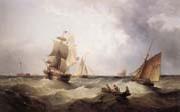 |
John ward of hull -- Click Here
|
|
British, 1798-1849 |
|
|
|
|
|
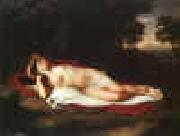 |
John Vanderlyn -- Click Here
|
|
1775-1852
John Vanderlyn (October 18, 1775 ?C September 23, 1852) was a American neoclassicist painter, was born at Kingston, New York.
He was employed by a print-seller in New York, and was first instructed in art by Archibald Robinson (1765-1835), a Scotsman who was afterwards one of the directors of the American Academy. He went to Philadelphia, where he spent time in the studio of Gilbert Stuart and copied some of Stuart's portraits, including one of Aaron Burr, who placed him under Gilbert Stuart as a pupil.
He was a proteg?? of Aaron Burr who in 1796 sent Vanderlyn to Paris, where he studied for five years. He returned to the United States in 1801 and lived in the home of Burr, then the Vice President, where he painted the well-known likeness of Burr and his daughter. In 1802 he painted two views of Niagara Falls, which were engraved and published in London in 1804. He returned to Paris in 1803, also visiting England in 1805, where he painted the Death of Miss McCrea for Joel Barlow. Vanderlyn then went to Rome, where he painted his picture of Marius amid the Ruins of Carthage, which was shown in Paris, and obtained the Napoleon gold medal there. This success caused him to remain in Paris for seven years, during which time he prospered greatly. In 1812 he showed a nude Ariadne (engraved by Durand, and now in the Pennsylvania Academy), which increased his fame. When Aaron Burr fled to Paris, Vanderlyn was for a time his only support.
Vanderlyn returned to the United States in 1815, and painted portraits of various eminent men, including Washington (for the U.S. House of Representatives), James Monroe, John C. Calhoun, Governor Joseph C. Yates, Governor George Clinton, Andrew Jackson, and Zachary Taylor. He also exhibited panoramas and had a "Rotunda" built in New York City which displayed panoramas of Paris, Athens, Mexico, Versailles (by himself), and some battle-pieces; but neither his portraits nor the panoramas brought him financial success, partly because he worked very slowly.
In 1842, through friendly influences, he was commissioned by Congress to paint The Landing of Columbus. Going to Paris, he hired a French artist, who, it is said, did most of the work. It was engraved for the United States five-dollar banknotes. He died in poverty at Kingston, New York, on 23 September 1852.
Vanderlyn was the first American to study in France instead of in England, and to acquire accurate draughtsmanship. He was more academic than his fellows; but, though faithfully and capably executed, his work was rather devoid of charm, according to the 1911 Encyclopaedia Britannica. His Landing of Columbus has been called (by Appleton's Cyclopedia) "hardly more than respectable."
His other works include portraits of Monroe, and Robert R Livingston (New York Historical Society). |
|
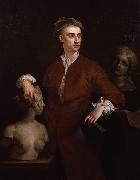 |
John Vanderbank -- Click Here
|
|
John Vanderbank (9 September 1694 - 23 December 1739) was an English portrait painter and book illustrator, who enjoyed a high reputation for a short while during the reign of King George I, but who died relatively young due to an intemperate and extravagant lifestyle.
Vanderbank was born in London, the eldest son of John Vanderbank Snr. His father was a Huguenot tapestry weaver, born in Paris, but who was forced to flee to Holland before coming to England where he became head of a Soho tapestry weaving factory.
Vanderbank studied under Sir Godfrey Kneller at James Thornhill's art academy in Great Queen Street from 1711 until 1720, when he joined with Louis Cheron to found his own academy in St. Martin's Lane. The venture proved a failure, and in 1729 he went to France to avoid his creditors. On his return he entered "the liberties of the Fleet" - mansion houses near Fleet prison, London, in which certain privileged prisoners could serve out their sentences in return for payment.
It was noted by George Vertue that "only intemperance prevented Vanderbank from being the greatest portraitist of his generation." He died of Tuberculosis in Holies Street, Cavendish Square, London, on 23 Dec. 1739, aged about 45, and was buried in Marylebone church. |
|
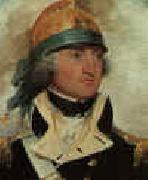 |
John Trumbull -- Click Here
|
|
1756-1843
John Trumbull Gallery
Trumbull was born in Lebanon, Connecticut, to Jonathan Trumbull, who was Governor of Connecticut from 1769 to 1784. He entered the 1771 junior class at Harvard University at age fifteen and graduated in 1773. Due to a childhood accident, Trumbull lost use of one eye, which may have influenced his detailed painting style.
As a soldier in the American Revolutionary War, Trumbull rendered a particular service at Boston by sketching plans of the British works, and witnessed the famous Battle of Bunker Hill. He was appointed second personal aide to General George Washington, and in June 1776 deputy adjutant-general to General Horatio Gates, but resigned from the army in 1777.
In 1780 he traveled to London where he studied under Benjamin West, who suggested to him that he paint small pictures of the War of Independence and miniature portraits, of which he produced about 250 in his lifetime.
On September 23, 1780 and October 2, 1780, British agent Major John Andr?? was, respectively, captured and hanged as a spy in America. News reached Europe, and as an officer of similar rank as Andr?? in the Continental Army, Trumbull was imprisoned for seven months in London's Tothill Fields Bridewell.
In 1784 he was again in London working under West, in whose studio he painted his Battle of Bunker Hill and Death of Montgomery, both of which are now in the Yale University Art Gallery.
In 1785 Trumbull went to Paris, where he made portrait sketches of French officers for The Surrender of Cornwallis, and began, with the assistance of Jefferson, Declaration of Independence, well-known from the engraving by Asher Brown Durand. This latter painting was purchased by the United States Congress along with his Surrender of General Burgoyne, Surrender at Yorktown, and Washington Resigning his Commission, and these paintings now hang in the United States Capitol. Trumbull's The Sortie Made by the Garrison of Gibraltar, 1789, owned by the Boston Athenaeum, is now in the Boston Museum of Fine Arts. |
|
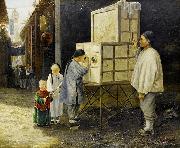 |
John Thomson -- Click Here
|
|
John Thomson (14 June 1837 - 29 September 1921) was a pioneering Scottish photographer, geographer and traveller. He was one of the first photographers to travel to the Far East, documenting the people, landscapes and artifacts of eastern cultures. Upon returning home, his work among the street people of London cemented his reputation, and is regarded as a classic instance of social documentary which laid the foundations for photojournalism. He went on to become a portrait photographer of High Society in Mayfair, gaining the Royal Warrant in 1881.
The son of William Thomson, a tobacco spinner and retail trader, and his wife Isabella, Thomson was born the eighth of nine children in Edinburgh in the year of Queen Victoria's accession. After his schooling in the early 1850s, he was apprenticed to a local optical and scientific instrument manufacturer, thought to be James Mackay Bryson. During this time, Thomson learned the principles of photography and completed his apprenticeship around 1858.
During this time he also undertook two years of evening classes at the Watt Institution and School of Arts (formerly the Edinburgh School of Arts, later to become Heriot-Watt University). He received the "Attestation of Proficiency" in Natural Philosophy in 1857 and in Junior Mathematics and Chemistry in 1858. In 1861 he became a member of the Royal Scottish Society of Arts, but by 1862 he had decided to travel to Singapore to join his older brother William, a watchmaker and photographer.
|
|
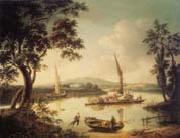 |
John Thomas Serres -- Click Here
|
|
1759-1825 English painter, born in London in December 1759. He was the eldest son of Dominic (1722-93), a successful marine painter who was to be one of the founder members of the Royal Academy.Son of Dominic Serres. John Thomas Serres's colourful career began with landscape painting. He later travelled extensively, spending periods in Paris (1789), Rome and Naples (1790-91), before succeeding his father to the office of Marine Painter to George III in 1793. He worked promisingly as a painter (in both oils and watercolour) of sea-pieces in the European tradition, advanced in England by Phillipe Jacques de Loutherbourg. After becoming Marine Draughtsman to the Admiralty in 1800 he took on the less challenging employment of making drawings and elevations of the west coasts of France and Spain. This connection with the Navy was probably related to his appointment as drawing instructor at Chelsea Naval School, London. |
|
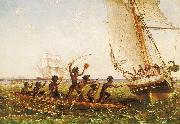 |
John Thomas Baines -- Click Here
|
|
(John) Thomas Baines (27 November 1820 - 8 May 1875) was an English artist and explorer of British colonial southern Africa and Australia. Born in King's Lynn, Norfolk, Baines was apprenticed to a coach painter at an early age. When he was 22 he left England for South Africa aboard the "Olivia" (captained by a family friend William Roome) and worked for a while in Cape Town as a scenic and portrait artist, and as official war artist during the so-called Eighth Frontier War for the British Army.
|
|
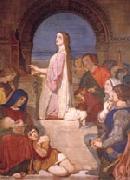 |
John Tenniel -- Click Here
|
|
English Golden Age Cartoonist and Illustrator.
(1820-1914)
English illustrator and painter. Impatient with the hierarchic structure of the curriculum at the Royal Academy schools in London, he left to follow a less formal education at the Clipstone Street Art Society's life and anatomy classes and in the British Museum's sculpture galleries and Print Room. His research into the history of costume and armour provided material for his early oils of chivalric scenes, which he exhibited at the Royal Academy (1837-42, 1851). Tenniel was among the artists commissioned to decorate the New Palace of Westminster, and he went in 1845 on a state-sponsored trip to Munich to study fresco technique. His contact with the school of Peter Cornelius while there confirmed his emphatic preference for a precisely drawn line. |
|
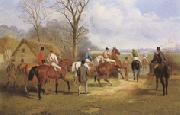 |
John sturgess -- Click Here
|
|
fl.1864-1903
was a hunting and racing artist and lithographer who worked mainly for the Illustrated London News between 1875 and 1885, and also exhibited widely in the London galleries, in particular at the Royal Society of British Artists and also at the Royal Hibernian Society in Dublin. He was known for being an accomplished illustrator of books and magazines, but is probably best remembered for his portrait of Blair Athol, the winner of the Derby in 1864. |
|
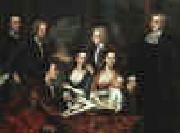 |
John Smibert -- Click Here
|
|
1688-1751
John Smibert Gallery
John Smybert (or Smibert) (1688 - 1751), Scottish American artist, was born in Edinburgh and died in Boston, Massachusetts.
He studied under Sir James Thornhill, and in 1728 accompanied Bishop Berkeley to America, with the intention of becoming professor of fine arts in the college which Berkeley was planning to found in Bermuda. The college, however, was never established, and Smybert settled in Boston, where he married in 1730.
In 1731 he painted "Dean George Berkeley and His Family," also called "The Bermuda group", now in the Yale University Art Gallery, Yale University, a group of eight figures; it is maintained that the person furthest to the left is actually the artist himself. He painted portraits of Jonathan Edwards and Judge Edmund Quincy (in the Boston Art Museum), Mrs Smybert, Peter Faneuil and Governor John Endecott (in the Massachusetts Historical Society), John Lovell (Memorial Hall, Harvard University), and probably one of Sir William Pepperrell; and examples of his works are owned by Harvard and Yale Universities, by Bowdoin College, by the Massachusetts Historical Society, and by the New England Historical and Genealogical Society.
Portrait of Edmund Quincy, attributed to John Smybert
Plaque at Granary Burying Ground in Boston commemorating SmybertBetween 1740-42, he served as architect for the original Faneuil Hall, which he designed in the style of an English country market. The hall burned down in 1761 but was restored, and then in 1806 greatly expanded and modified by Charles Bulfinch.
His son Nathaniel was also a painter. Smybert lies in an unmarked grave in the Granary Burying Ground in Boston. |
|
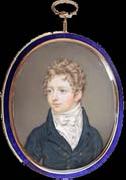 |
John Smart -- Click Here
|
|
English Rococo Era Miniaturist, ca.1741-1811,English miniature painter, was born in Norfolk; he became a pupil of Cosway, and is frequently alluded to in his correspondence.
This artist was director and vice-president of the Incorporated Society of Artists, and exhibited with that society. He went to India in 1788 and obtained a number of commissions in that country. He settled down in London in 1797 and there died. He married Edith Vere, and is believed to have had only one son, who died in Madras in 1809.
He was a man of simple habits, and a member of the Society of Sandemanians. Many of his pencil drawings still exist in the possession of the descendants of a great friend of his only sister. Several of his miniatures are in Australia and belong to a cadet branch of the family.
His work is entirely different from that of Cosway, quiet and grey in its colouring, with the flesh tints elaborated with much subtlety and modelled in exquisite fashion. He possessed a great knowledge of anatomy, and his portraits are drawn with greater anatomical accuracy and possess more distinction than those of any miniature painter of his time.
|
|
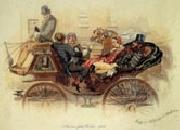 |
John Skinner Prout -- Click Here
|
|
(1805-76), nephew of the famous English watercolourist Samuel Prout (1783-1852) |
|
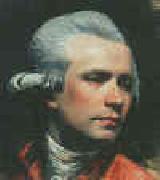 |
John Singleton Copley -- Click Here
|
|
American Colonial Era Painter, 1738-1815
John Singleton Copley (1738[1] - 1815) was an American painter, born presumably in Boston, Massachusetts and a son of Richard and Mary Singleton Copley, both Irish. He is famous for his portrait paintings of important figures in colonial New England, depicting in particular middle-class subjects. His paintings were innovative in their tendency to depict artifacts relating to these individuals' lives. |
|
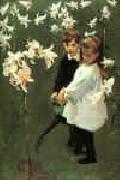 |
John Singer Sargent -- Click Here
|
|
1856-1925
John Singer Sargent Locations
John Singer Sargent (January 12, 1856 ?C April 14, 1925) was the most successful portrait painter of his era. During his career, he created roughly 900 oil paintings and more than 2,000 watercolors, as well as countless sketches and charcoal drawings. His oeuvre documents worldwide travel, from Venice to the Tyrol, Corfu, the Middle East, Montana, Maine, and Florida.
Before Sargent??s birth, his father FitzWilliam was an eye surgeon at the Wills Hospital in Philadelphia. After his older sister died at the age of two, his mother Mary (n??e Singer) suffered a mental collapse and the couple decided to go abroad to recover. They remained nomadic ex-patriates for the rest of their lives. Though based in Paris, Sargent??s parents moved regularly with the seasons to the sea and the mountain resorts in France, Germany, Italy, and Switzerland. While she was pregnant, they stopped in Florence, Italy because of a cholera epidemic, and there Sargent was born in 1856. A year later, his sister Mary was born. After her birth FitzWilliam reluctantly resigned his post in Philadelphia and accepted his wife??s entreaties to remain abroad. They lived modestly on a small inheritance and savings, living an isolated life with their children and generally avoiding society and other Americans except for friends in the art world. Four more children were born abroad of whom two lived past childhood.
Though his father was a patient teacher of basic subjects, young Sargent was a rambunctious child, more interested in outdoor activities than his studies. As his father wrote home, ??He is quite a close observer of animated nature.?? Contrary to his father, his mother was quite convinced that traveling around Europe, visiting museums and churches, would give young Sargent a satisfactory education. Several attempts to give him formal schooling failed, owning mostly to their itinerant life. She was a fine amateur artist and his father was a skilled medical illustrator. Early on, she gave him sketchbooks and encouraged drawing excursions. Young Sargent worked with care on his drawings, and he enthusiastically copied images from the Illustrated London News of ships and made detailed sketches of landscapes. FitzWilliam had hoped that his son??s interest in ships and the sea might lead him toward a naval career.
At thirteen, his mother reported that John ??sketches quite nicely, & has a remarkably quick and correct eye. If we could afford to give him really good lessons, he would soon be quite a little artist.?? At age thirteen, he received some watercolor lessons from Carl Welsch, a German landscape painter. Though his education was far from complete, Sargent grew up to be a highly literate and cosmopolitan young man, accomplished in art, music, and literature. He was fluent in French, Italian, and German. At seventeen, Sargent was described as ??willful, curious, determined and strong?? (after his mother) yet shy, generous, and modest (after his father). He was well-acquainted with many of the great masters from first hand observation, as he wrote in 1874, ??I have learned in Venice to admire Tintoretto immensely and to consider him perhaps second only to Michael Angelo and Titian.?? |
|
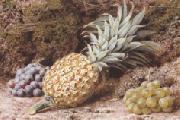 |
John Sherrin -- Click Here
|
|
1819-1896
Pencil and watercolour heightened with bodycolour
12x16in
30.5x40.6cm
|
|
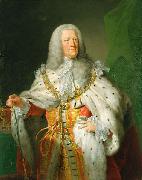 |
John Shackleton -- Click Here
|
|
was a British painter and draughtsman who produced history paintings and portraits. His parents and origins are unknown.
Shackleton painted several surviving portraits, for example of Henry Pelham (National Portrait Gallery), William Windham (1717 - 1761; now at Felbrigg Hall, Norfolk), and of John Bristowe, steward to the first duke of Newcastle (now in the Reitlinger Museum of Fine Art, Maidenhead).
From 1749 he was Principal Painter in Ordinary to George II and George III. He continued to be paid for portraits of the king and queen up even during 1765 - 6, when their official portraits were being done by Allan Ramsay. Several examples of his and his studio's output of royal portraits survive - one of George II dated 1755 is in the Scottish National Portrait Gallery, Edinburgh; another of George II in Room 2 of the British Museum, London (commissioned by the museum in 1759 - the Museum also holds engravings after his paintings), along with two more of George II in the Royal Collection and others in Fishmongers' Hall, London, and Maidenhead Museum.
|
|
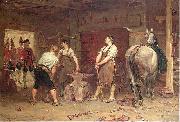 |
John Seymour Lucas -- Click Here
|
|
(21 December 1849 - 8 May 1923) was a Victorian English historical and portrait painter as well as an accomplished theatrical costume designer. He was born into an artistic London family, and originally trained as a woodcarver, but turned his attention to portrait painting and entered first the St. Martin's Lane Art School and later the Royal Academy Schools. Here he met his French wife, fellow artist Marie Cornelissen, whom he married in 1877. Lucase artistic education included extensive travels around Europe, particularly Holland and Spain, where he studied the Flemish and Spanish Masters. He first started exhibiting in 1872, was elected an associate member of the Royal Academy in 1876 and a full Royal Academician in 1898.
John Seymour Lucas was first and foremost a historical genre painter with a particular talent for realism in the depiction of costumes and interiors. Inspired by van Dyck and particularly Diego Velezquez, he excelled in depicting scenes from the English 16th to 18th century Tudor and Stuart periods, including in particular the Spanish Armada, Preparing for the Voyage, the English Civil War and the Jacobite rebellions.
His first major work to achieve widespread public acclaim was Rebel Hunting after Culloden, executed in 1884. It was praised not only for the obvious tension between the muscular blacksmiths and the redcoated forces of law and order (or repression) but for the extraordinary realism in the depiction of the rough smithy and glowing horsehoe on the anvil. In 1885 his next major work whas "Preparing for the Voyage".
As his reputation grew, Lucas increasingly mixed in society circles, and became firm friends with the famous society portrait painter John Singer Sargent who was his almost exact contemporary. A portrait of Lucas executed by John Singer Sargent is displayed in Tate Britain. Towards the 1890s John Seymour Lucas executed a number of major works for prestigious public buildings or royal clients. These include: The Flight of the Five Members (Houses of Parliament), The Granting of the Charter of the City of London (Royal Exchange), Reception by HM King Edward VII of the Moorish Ambassador (Royal Collection), HRH the Prince of Wales in German Uniform (Royal Collection)
Apart from executing over 100 major oil paintings and a host of drawings, Lucas was renowned as a set and costume designer for the historical dramas popular on the late Victorian and early Edwardian stages. One of his more unusual commissions was the "Duke of Normandy" costume for the ill-fated prince Alfred of Saxe Coburg-Gotha for the Devonshire House Ball in 1897. Lucas was also a prolific watercolour painter and was elected a member of the Institute of Painters in Water Colours in 1877.
During most of his artistic career, John Seymour Lucas lived in a purpose-built studio in South Hampstead, London, designed for him by his friend and fellow artist, architect Sydney Williams-Lee.
He retired from painting towards the end of World War I, and moved to Blythburgh, Suffolk, where re-designed a house next to the church known as 'The Priory'. Lucas died in 1923 and is interred in Blythburgh church yard. His son, Sydney Seymour Lucas, was also an artist, and illustrator.
|
|
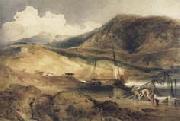 |
John sell cotman -- Click Here
|
|
English Romantic Painter, 1782-1842
English painter and etcher. Cotman was born in the parish of St Mary Coslany, Norwich, the son of Edmund Cotman, a hairdresser, later a haberdasher, and Ann Sell. In 1793 he entered Norwich Grammar School as a 'freeplacer'. In 1798 he moved to London, where he worked as an assistant to the publisher Rudolph Ackermann. Following in the footsteps of Turner and Thomas Girtin he joined Dr Monro's 'Academy' in 1799 and became a member of the sketching society that had developed around the personality and talent of Girtin. |
|
 |
john scarlett davis -- Click Here
|
|
John Scarlett Davis (1 September 1804 - 29 September 1845), or Davies, was an English painter of the first half of the nineteenth century.
Davis was born in Leominster, the son of James Davis, a watchmaker; Scarlett was his mother's maiden name. At the age of eleven, Davis won an award from the local society for the encouragement of the arts. He was educated at the Royal Academy of Art School in London, and began exhibiting his works at the annual Royal Academy shows in 1825. He was influenced by the work of his contemporary, Richard Parkes Bonington.
Davis painted portraits, landscapes, and church interiors, and developed a distinctive specialty in painting the interiors of art galleries. His picture The Interior of the British Institution Gallery (1829) records a collection of Old Masters. His watercolor of the collection of Benjamin Godfrey Windus (1835) shows the Turner pictures on the walls. (John Ruskin studied those Turners while writing his Modern Painters.) Davis painted the interiors of the Louvre as well. Between 1842 and 1845 he was commissioned to draw copies of the paintings in the collections of the British royal palaces.
Davis painted scenes on the Continent during his travels there. He was in Florence in 1834, and Amsterdam in 1841. He painted the interior of the Uffizi Gallery.
Davis's later years were marred by alcoholism and spells of imprisonment. His posthumous reputation suffered as a result.
Davis's name is almost identical to that of John Scarlett-Davies, a modern video artist and director. |
|
 |
John Scarlett Davies -- Click Here
|
|
Australian Painter, 1864-1939 |
|
 |
John Samuel Raven -- Click Here
|
|
(1829-1877) was an English landscape painter.
Raven was born in Suffolk in 21 Aug. 1829. He was the son of the Rev. Thomas Raven, a clergyman of the Church of England, who had considerable talent as an amateur artist, as may be seen from six water-colour drawings by him in the South Kensington Museum.
John Raven was, however, almost entirely self-taught, initially by studying the works of John Crome and John Constable. He exhibited at the Academy as early as 1845, and his works also appeared at the British Institution. This part of his career was focused on views of the area where he lived, near St. Leonards[disambiguation needed]. He at first fell under the influence of the Norwich school, but his maturer works, which show much poetic feeling, bear traces of pre-Raphaelitism. It was his custom to prepare elaborate cartoons for his pictures. He was drowned while bathing at Harlech in 13 June 1877.
He married Margaret Sinclair Dunbar in 1869. |
|
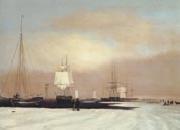 |
John Samuel Blunt -- Click Here
|
|
b.Portsmouth 1798 d.At Sea 1835
|
|
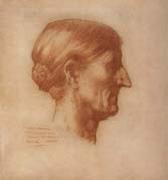 |
John Russell -- Click Here
|
|
English Painter, 1745-1806,English pastellist, painter, writer and astronomer. His father, also called John Russell (1711-1804), was a bookseller, printseller and amateur artist. Russell was educated at Guildford grammar school and won premiums from the Society of Artists for drawings in 1759 and 1760. He was apprenticed to Francis Cotes and set up his own practice in 1767. In 1770 he entered the Royal Academy Schools, London, winning the silver medal for figure drawing. He exhibited at the Society of Artists in 1768 and annually at the Royal Academy from 1769 to 1806. He was elected ARA in 1772 and RA in 1788, when he became Crayon Painter to King George III and to George, Prince of Wales. He painted some rather stilted portraits in oil |
|
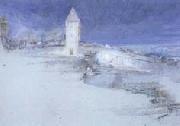 |
John Ruskin,HRWS -- Click Here
|
|
1819-1900
English academic and critic, who had an enormous influence not only on architectural style but on the ways in which standards of aesthetics were judged. He used an Evangelical and polemical tone in his writings that not only reached a mass audience but received the approval of the Ecclesiologists. Initially encouraged by J. C. Loudon, he contributed to some of Loudon's publications, but his key works date from the late 1840s and 1850s. The Gothic Revival was well established when Ruskin published The Seven Lamps of Architecture (1849), which was an immediate success, encapsulating the mood of the period rather than creating new ideas. He argued that architecture should be true, with no hidden structure, no veneers or finishes, and no carvings made by machines, and that Beauty in architecture was only possible if inspired by nature. As exemplars worthy of imitation (he argued that the styles known to Man were quite sufficient, and that no new style was necessary) he selected Pisan Romanesque, early Gothic of Western Italy, Venetian Gothic, and English early Second Pointed as his paradigms. In the choice of the last, the style of the late C13 and early C14, he was echoing A. W. N. Pugin's preferences as well as that of most ecclesiologically minded Gothic Revivalists such as G. G. Scott. The Stones of Venice (1851C3) helped to promote that phase of the Gothic Revival in which Continental (especially Venetian) Gothic predominated. Deane and Woodward's University Museum, Oxford (1854C60), is an example of Venetian or Ruskinian Gothic. In particular, structural polychromy, featuring colour in the material used, rather than applied, was popularized by Ruskin's writings. |
|
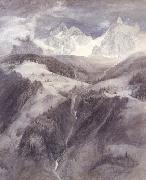 |
John Ruskin -- Click Here
|
|
English Romantic Writer and Painter, 1819-1900
English art critic. Born into a wealthy family, Ruskin was largely educated at home. He was a gifted painter, but the best of his talent went into his writing. His multivolume Modern Painters (1843 C 60), planned as a defense of painter J.M.W. Turner, expanded to become a general survey of art. In Turner he saw "truth to nature" in landscape painting, and he went on to find the same truthfulness in Gothic architecture. His other writings include The Seven Lamps of Architecture (1849) and The Stones of Venice (1851 C 53). He was also a defender of the Pre-Raphaelites. In 1869 he was elected Oxford's first Slade professor of fine art; he resigned in 1879 after James McNeill Whistler won a libel suit against him. |
|
 |
John Rogers Herbert -- Click Here
|
|
English historical painter and portraitist .
British, 1810-1890.
was an English painter who is most notable as a precursor of Pre-Raphaelitism. Herbert was born in Maldon, Essex. In 1825, he moved to London to study at the Royal Academy. His early works were influenced by the troubadour style of Richard Parkes Bonington. Subjects showed the influence of Byron and exotic episodes of Venetian history. Haydee (1834) depicted the heroine of Byron's poem Don Juan. Herbert's first major success was The Appointed Hour (1835), depicting a melodramatic scene in which a Venetian man lies murdered at the place appointed for a tryst with his lover. The work became a popular engraving. Herbert followed it with other dramatic subjects such as A Prisoner of Condottieri Freed (1836) and Desdemona asks for Cassio (1838). After he was chosen to paint a portrait of Princess Victoria, before she became queen, he became a favourite portrait painter of the aristocracy. Around this time, he came under the influence of the architect William Payne, a convert to Catholicism. In 1840, Herbert also converted to the Catholic Church. He then painted mainly religious subjects in a style influenced by the artists of the Nazarene movement. Herbert was elected to membership of the Royal Academy in 1846. Herbert's paintings The First Introduction of Christianity into Great Britain (1842) and Our Saviour Subject to his Parents in Nazareth (1847) were the inspiration for the two most important early works of William Holman Hunt and John Everett Millais, founders of Pre-Raphaelitism. The two paintings, Hunt's A Converted British Family Sheltering a Christian Missionary and Millais' Christ in the House of His Parents were exhibited at the RA in 1850 to great controversy. |
|
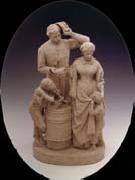 |
John Rogers -- Click Here
|
|
American Sculptor, 1829-1904, He was an American sculptor who produced very popular, relatively inexpensive figurines in the latter 19th century. He became famous for his small genre sculptures, popularly termed "Rogers Groups", which were mass produced in cast plaster. A total of 80,000 copies of almost 80 Rogers Groups were sold across the United States and abroad. At the height of their popularity, Rogers' figurines graced the parlors of homes in the United States and were found as far away as Chile and Australia. The English novelist Charles Reade furnished his home with all the Rogers figurines available to him, and in the Dakota Territory, Lt. Col. George Custer and his wife had one. |
|
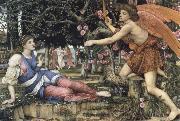 |
John Roddam Spencer Stanhope -- Click Here
|
|
English Pre-Raphaelite Painter, 1829-1908,English painter. The second son of Yorkshire landed gentry, he was educated at Rugby and Christ Church, Oxford. In 1850 he studied in London with G. F. Watts, through whom he entered the artistic circle at Little Holland House, where he met D. G. Rossetti and Edward Burne-Jones. In 1857 Rossetti invited him to paint at the Oxford Union (Sir Gawaine and the Damsels at the Fountain), and in 1858 Stanhope occupied a studio next to Rossetti's at Chatham Place, Blackfriars (London), where he painted Thoughts of the Past (London, Tate); a modern-life subject indebted to Rossetti, it shows a prostitute recalling her former life. Stanhope's close friendship with Burne-Jones proved a more decisive influence on his work that, in the 1860s, consisted of dreamlike poetic and mythological subjects often set in quaint, enclosed spaces, as in I Have Trod the Winepress Alone |
|
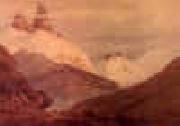 |
John Robert Cozens -- Click Here
|
|
British
1752-1797
). Painter, draughtsman and printmaker, son of (1) Alexander Cozens.
He was taught by his father, and an album by John Robert (Aberystwyth, N. Lib. Wales) indicates that he also learnt to sketch landscape directly from nature. The album contains drawings that record sketching tours to Nacton, near Ipswich, Suffolk (Aug 1768); day trips to the outskirts of London: Greenwich and Blackheath (1768, 1771), Epsom (1768) and Hampstead (1770-71); and a trip to Matlock, Derbys (June 1772). The earliest of these sketches are careful pencil drawings, some later reworked in pen, ink and wash, and there is at least one attempt at added colour. Later drawings are freer, either noting an idea for a composition or recording light and shade with rapid washes of ink over pencil. His father worked mainly in monochrome brown or grey washes, and John Robert earliest exhibits (he exhibited at the Society of Artists every year from 1767 to 1771) were also in this medium. |
|
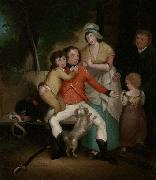 |
John Ritto Penniman -- Click Here
|
|
John Ritto Penniman (1782-1841) was a painter in Boston, Massachusetts, USA. He created portraits, landscapes, and allegorical paintings, as well as designs for engravings, such as the official seal of the city of Boston in 1822. He also worked as an assistant to Gilbert Stuart. Penniman died in 1841 in Baltimore. |
|
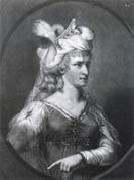 |
John Raphael Smith -- Click Here
|
|
English Painter, 1752-1812,English printmaker, publisher and painter. The youngest son of the landscape artist Thomas Smith of Derby (d Bristol, 12 Sept 1767), he was apprenticed to a linen draper at the age of ten and around 1767 became a linen draper's assistant in London. He seems to have taught himself to paint miniatures and produced his first mezzotint in 1769, from Henry Benbridge's portrait of General Pascal Paoli (San Francisco, CA Pal. Legion of Honor). Smith married and opened a draper's shop in Exeter Exchange; about 1773 he began to engrave professionally and sold prints from the same shop. |
|
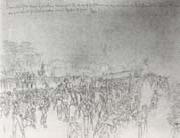 |
John R.Chapin -- Click Here
|
|
1823 - 1904,was a 19th-century American artist and illustrator, who worked for Harper's Magazine. He was especially noted for a series of illustrations entitled Artist life in the highlands of New Jersey published in April 1860 which gave a realistic depiction of the daily life of miners. |
|
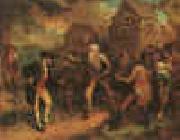 |
John Quidor -- Click Here
|
|
1801-1888
Quidor was born in Gloucester Co., N. J., and in 1826 moved to New York City where he studied painting under John Wesley Jarvis and Henry Inman. Afterward he lived on a farm near Quincy, Illinois, but returned to New York City in 1851. He was obliged to support himself by painting the panels of stage coaches and fire engines and died in abject poverty.
Although Quidor was little appreciated in his own time, after his death he was accorded a place among the best early American artists. His paintings establish a mysterious romantic setting for scenes in which he mingled macabre elements with an earthy humor. Many of his works, such as Ichabod Crane Pursued by the Headless Horseman, in the Smithsonian American Art Museum, were inspired by the writings of Washington Irving, who was a personal friend. Irving's A History of New York gave Quidor the subjects for the four paintings in the Brooklyn (N. Y.) Institute: Dancing on the Battery (c. 1860), Peter Stuyvesant's Wall Street Gate (1864), Voyage of the Good Oloff up the Hudson (1866), and The Voyage from Communipaw to Hell Gate (1866). These show Quidor's characteristic mellow and harmonious color, poetic imagination, and naïve humor.
He is represented in the Brooklyn Museum by three paintings: Dorothea, Money Diggers, and Wolfert's Will. He also painted religious subjects such as Jesus Blessing the Sick. |
|
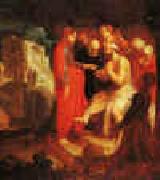 |
John Pynas -- Click Here
|
|
1583-1631 Dutch John Pynas Gallery |
|
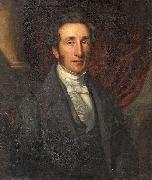 |
John Ponsford -- Click Here
|
|
(1790- 1870 )
painted Portrait of a gentleman. Signed and dated Ponsford 1842 |
|
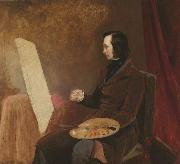 |
John Phillip -- Click Here
|
|
(April 19, 1817-1867) was a Victorian era painter best known for his portrayals of Spanish life. He was nicknamed "Spanish Phillip".
Born into a poor family in Aberdeen in Scotland, Phillip's artistic talent was recognised at an early age. His education at the Royal Academy of Arts was paid for by a wealthy patron. While at the academy Phillip became a member of The Clique a group of aspirant artists organised by Richard Dadd. The Clique considered themselves to be followers of Hogarth and Wilkie. Phillip's own career was to follow that of fellow-Scot Wilkie very closely, beginning with carefully detailed paintings depicting the lives of Scottish crofters, and moving on to much more broadly painted scenes of Spanish life influenced by Murillo and Velezquez.
Phillip's early works tended to depict pious Scots families, but in 1851, after he was advised to travel to southern Europe for his health he visited Spain. Thereafter he concentrated on Spanish subjects. The first of these, The Letter Writer, Seville indicated the influence of Pre-Raphaelitism, a movement he had previously opposed, along with most other members of The Clique, despite his friendship with Millais, one of its leaders. He was so influenced by his travels that he advised other artists to do the same. Some artists, such as Edwin Long, took this advice and were similarly inspired.
In the late 1850s and 1860s Phillip's style became much broader and more painterly, in line with Millais's late work. Phillip's two most important paintings in these years were The Early Career of Murillo (1864) and La Gloria (1865, National Gallery of Scotland). The first depicted the young Murillo drawing his art from Spanish street-life; the second portrayed a Spanish wake for a dead child.
Phillip married Richard Dadd's sister, but like her brother she became insane. Phillip died of a stroke while visiting William Powell Frith. Phillip's self-portrait, "The Evil Eye", commissioned by his close friend Patrick Allan-Fraser, is in Hospitalfield House in Arbroath along with portraits of other members of The Clique.
|
|
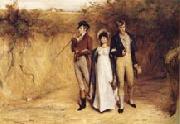 |
John Pettie -- Click Here
|
|
British Painter, 1839-1893
He was brought up in Edinburgh and East Lothian, and in 1855 he entered the schools of the Trustees' Academy, Edinburgh, sponsored by the history painter James Drummond (1816-77). He studied under Robert Scott Lauder, and among his fellow students were WILLIAM QUILLER ORCHARDSON, Thomas Graham (1840-1906), George Paul Chalmers (1833-78), John Burr (1831-93) and John MacWhirter, several of whom later became part of Pettie's circle of Scottish artist friends in London. Pettie first exhibited at the Royal Scottish Academy in 1858 with In Trabois House (untraced), a scene from Sir Walter Scott's The Fortunes of Nigel, and he began sending work to the Royal Academy in 1860. From 1858 he provided illustrations for the periodical Good Words, and, encouraged by the reviews received for his early Royal Academy exhibits, such as The Armourers (exh. RA 1860) and What D'Ye Lack' (exh. RA 1861), when Good Words transferred its headquarters, Pettie moved to London in 1862. He shared a studio in Fitzroy Square with Orchardson and Graham from 1863 until his marriage to Elizabeth Ann Bossom on 25 August 1865. He subsequently lived at various addresses, gravitating towards the wealthy artistic colony in St John's Wood, where in 1882, at 2 Fitzjohn's Avenue, he built a neo-Georgian house and studio, The Lothians (destr.). This reflected not only the professional circle in which Pettie moved but also the rapid financial success that he achieved in London. From the mid-1860s his most important patron was John Newton Mappin, founder of the Mappin Art Gallery, |
|
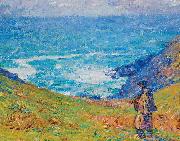 |
John Peter Russell -- Click Here
|
|
(16 June 1858 -22 April 1930) was an Australian impressionist painter.
John Peter Russell was born at the Sydney suburb of Darlinghurst, the eldest of four children of John Russell, a Scottish engineer, his wife Charlotte Elizabeth, nee Nicholl, from London. J. P. Russell was a nephew of Sir Peter Nicol Russell. After his father's death J. P. Russell enrolled at the Slade School of Fine Art, University College, London, on 5 January 1881 and studied under Alphonse Legros for three years.Russell then went to Paris to study painting under Fernand Cormon. (His fellow students there included Henri de Toulouse-Lautrec and Émile Bernard.) Russell was a man of means and having married a beautiful Italian, Mariana Antoinetta Matiocco, he settled at Belle Île off the coast of Brittany, where he established an artists' colony. He would have 11 children with Matiocco, of whom six survived.
John Peter Russell: Vincent van Gogh, 1886, Van Gogh Museum, AmsterdamRussell had met Vincent van Gogh in Paris and formed a friendship with him. Van Gogh spoke highly of Russell's work, and after his first summer in Arles in 1888 he sent twelve drawings of his paintings to Russell, to inform him about the progress of his work. Claude Monet often worked with Russell at Belle Île and influenced his style, though it has been said that Monet preferred some of Russell's Belle Île seascapes to his own. |
|
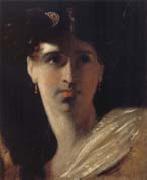 |
John Opie -- Click Here
|
|
English Painter, 1761-1807,English painter. He was born in a tin-mining district, where his father was a mine carpenter. He had a natural talent for drawing and was taken up by an itinerant doctor, John Wolcot (the poet Peter Pindar, 1738-1819), who was an amateur artist and had a number of well-connected friends. Wolcot taught Opie the rudiments of drawing and painting, providing engravings for him to copy and gaining him access to country-house collections. Opie's early portraits, such as Dolly Pentreath (1777; St Michael's Mount, Cornwall, Lord St Levan priv. col.), are the work of a competent provincial painter and owe much to his study of engravings after portraits by Rembrandt. His attempts at chiaroscuro and impasto in Rembrandt's manner gave his pictures a maturity that clearly startled contemporary audiences expecting to see works by an untutored artist. Thus in 1780, when a picture by him was exhibited in London at the Society of Artists with the description 'a Boy's Head, an Instance of Genius, not having ever seen a picture', Opie was hailed as 'the Cornish Wonder'. When he himself arrived in London, where he was promoted by Wolcot and his paintings were exhibited at the Royal Academy in 1781 and 1782, he was seen as a phenomenon, impressing even Joshua Reynolds, who is reputed to have remarked that Opie was 'like Caravaggio and Velasquez in one'. |
|
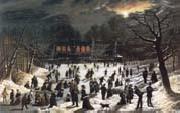 |
John O Brien Inman -- Click Here
|
|
American, 1828-1896 |
|
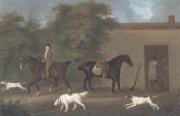 |
John Nost Sartorius -- Click Here
|
|
English Painter, 1759-1828 |
|
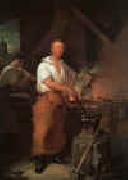 |
John Neagle -- Click Here
|
|
1796-1860
John Neagle Gallery
Neagle's training in art began with instruction from the drawing-master Pietro Ancora and an apprenticeship to Thomas Wilson, a well-connected painter of signs and coaches in Philadelphia. Wilson introduced him to the painters Bass Otis and Thomas Sully, and Neagle became a protege of the latter. In 1818 Neagle decided to concentrate exclusively on portraits, setting up shop as an independent master.
Aside from brief sojourns in Lexington, Kentucky, and New Orleans, Louisiana, he spent his career in Philadelphia. In May 1826 he married Sully's stepdaughter Mary, and for a time the son-in-law and father-in-law dominated the field of portraiture in the city. Neagle served as Director of the Pennsylvania Academy of Fine Arts, and was also a founder and president (1835-43) of the Artist's Fund Society of Philadelphia. |
|
 |
John Mundell -- Click Here
|
|
painted Punting Down the River in 19th Century
|
|
|
|
|
|
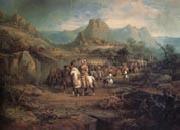 |
John Mix Stanley -- Click Here
|
|
A famous painter of Indians and Indian scen .
American , 1814-1872
American , 1814-1872,was an American painter of landscapes, portraits and Native American life. He was born in Canandaigua, New York and orphaned at the age of 12. At age 14, Stanley became an apprentice to a coach maker. Looking for better work, he moved to west in 1832 and became a painter of signs and portraits. In spring 1843 Stanley accompanied the party of Indian agent Pierce M. Butler to the Tehuacana Creek Council. At the outbreak of the Mexican War in 1845, John Mix Stanley joined Colonel Stephen Watts Kearney's expedition to California and produced many sketches and paintings of the campaign. He traveled to Hawaii in 1848 and spent a year painting portraits of members of the royal family. He traveled across the Isthmus of Panama in 1853. He also painted Comanche warriors in their natural environment. He moved to Detroit in 1864 and remained there for the rest of his life. Stanley helped to found a forerunner of the Detroit Institute of Arts and to incorporate the National Gallery and School of Arts. Stanley's primary interests and sympathies were with the Indians. The Smithsonian exhibited his pictures, but Congress never appropriated monies for them. More than 200 of his works were destroyed in the Smithsonian fire of 1865. |
|
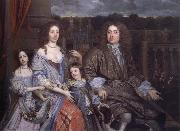 |
John Michael Wright -- Click Here
|
|
English Baroque Era Painter, ca.1617-1694,was a British baroque portrait painter. Wright trained in Edinburgh under the Scots painter George Jamesone, and acquired a considerable reputation as an artist and scholar during a long sojourn in Rome. There he was admitted to the Accademia di San Luca, and was associated with some of the leading artists of his generation. He was engaged by Archduke Leopold Wilhelm of Austria, the governor of the Spanish Netherlands, to acquire artworks in Oliver Cromwell's England in 1655. He took up permanent residence in England from 1656, and served as court painter before and after the English Restoration. A convert to Roman Catholicism, he was a favourite of the restored Stuart court, a client of both Charles II and James II, and was a witness to many of the political manoeuvrings of the era. In the final years of the Stuart monarchy he returned to Rome as part of an embassy to Pope Innocent XI. Wright is currently rated as one of the leading indigenous British painters of his generation and largely for the distinctive realism in his portraiture. Perhaps due to the unusually cosmopolitan nature of his experience, he was favoured by patrons at the highest level of society in an age in which foreign artists were usually preferred. Wright's paintings of royalty and aristocracy are included amongst the collections of many leading galleries today. |
|
 |
John Melhuish Strudwick -- Click Here
|
|
1849-1937
British
John Melhuish Strudwick Gallery |
|
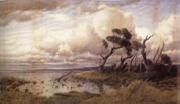 |
John Mather -- Click Here
|
|
Australian painter, etcher and teacher.
1848-1916
|
|
|
|
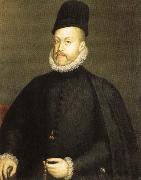 |
john masefield -- Click Here
|
|
(born June 1, 1878, Ledbury, Herefordshire, Eng. ?? died May 12, 1967, near Abingdon, Berkshire) English poet. He went to sea in his youth, then lived precariously for several years in the U.S. before settling in London. He is best known for his poems of the sea, Salt-Water Ballads (1902, including "Sea Fever" and "Cargoes"), and for his long narrative poems, such as The Everlasting Mercy (1911), containing phrases of colloquial coarseness that were unknown in earlier 20th-century English verse. After he became poet laureate in 1930, his poetry became more austere. He also wrote adventure novels, sketches, and works for children.
|
|
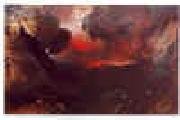 |
John Martin -- Click Here
|
|
British
1789-1854
John Martin Gallery
His first exhibited subject picture, Sadak in Search of the Waters of Oblivion (now in the St. Louis Art Museum), was hung in the Ante-room of the Royal Academy in 1812, and sold for fifty guineas. It was followed by the Expulsion (1813), Paradise (1813), Clytie (1814), and Joshua Commanding the Sun to Stand Still upon Gibeon (1816). In 1821 appeared his Belshazzar's Feast, which excited much favorable and hostile comment, and was awarded a prize of £200 at the British Institution, where the Joshua had previously carried off a premium of £100. Then came the Destruction of Herculaneum (1822), the Creation (1824), the Eve of the Deluge (1841), and a series of other Biblical and imaginative subjects. The Plains of Heaven is thought to reflect his memories of the Allendale of his youth.
Martin's large paintings were inspired by "contemporary dioramas or panoramas, popular entertainments in which large painted cloths were displayed, and animated by the skilful use of artificial light. Martin has often been claimed as a forerunner of the epic cinema, and there is no doubt that the pioneer director D. W. Griffith was aware of his work." In turn, the diorama makers borrowed Martin's work, to the point of plagiarism. A 2000-square-foot version of Belshazzar's Feast was mounted at a facility called the British Diorama in 1833; Martin tried, but failed, to shut down the display with a court order. Another diorama of the same picture was staged in New York City in 1835. These dioramas were tremendous successes with their audiences, but wounded Martin's reputation in the serious art world. |
|
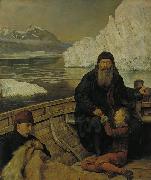 |
John Maler Collier -- Click Here
|
|
(27 January 1850 - 11 April 1934), called 'Jack' by his family and friends, was a leading English artist, and an author. He painted in the Pre-Raphaelite style, and was one of the most prominent portrait painters of his generation. Both his marriages were to daughters of Thomas Henry Huxley. He studied painting at the Munich Academy where he enrolled on 14 April 1875 (Register: 3145) at the age of 25.
Collier was from a talented and successful family. His grandfather, John Collier, was a Quaker merchant who became a Member of Parliament. His father (who was a Member of Parliament, Attorney General and, for many years, a full-time judge of the Privy Council) was created the first Lord Monkswell. He was also a member of the Royal Society of British Artists. John Collier's elder brother, the second Lord Monkswell, was Under-Secretary of State for War and Chairman of the London County Council.
Collier's first wife, Marian Huxley, 1883In due course, Collier became an integral part of the family of Thomas Henry Huxley PC, sometime President of the Royal Society. Collier married two of Huxley's daughters and was "on terms of intimate friendship" with his son, the writer Leonard Huxley. Collier's first wife, in 1879, was Marian (Mady) Huxley. She was a painter who studied, like her husband, at the Slade and exhibited at the Royal Academy and elsewhere. After the birth of their only child, a daughter, she suffered severe post-natal depression and was taken to Paris for treatment where, however, she contracted pneumonia and died in 1887.
In 1889 Collier married Mady's younger sister Ethel Huxley. Until the Deceased Wife's Sister's Marriage Act 1907 such a marriage was not possible in England, so the ceremony took place in Norway. Collier's daughter by his first marriage, Joyce, was a portrait miniaturist, and a member of the Royal Society of Miniature Painters. By his second wife he had a daughter and a son, Sir Laurence Collier KCMG, who was the British Ambassador to Norway 1941-51.
|
|
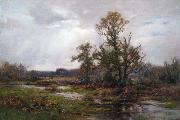 |
John MacWhirter -- Click Here
|
|
(27 March 1839 Slateford, Water of Leith - 28 January 1911 London) was a Scottish landscape painter.
John was the third of four children. He attended a school in Colinton, and after his father's death was apprenticed to Oliver & Boyd, booksellers in Edinburgh. He stayed there for only a few months and then in 1851 enrolled at the Trustees Academy under Robert Scott Lauder and John Ballantyne (1815-97). He spent long periods sketching and studying nature outdoors. His first painting to be exhibited at the Royal Scottish Academy at age 14, was 'Old Cottage at Braid'. In 1880, he was made an Honorary Member of the Royal Scottish Academy. Exploring and painting abroad he visited Italy, Sicily, Switzerland, Austria, Turkey, Norway and the U.S.A. - the Alps being a great inspiration. He moved to London in 1867 and on 4 May 1893 was elected a Royal Academician.
MacWhirter specialised in romantic landscapes with a great fondness for trees, spending much time in the hilly countryside of Perthshire. Initially, under the influence of John Everett Millais, he experimented with the detailed images of the Pre-Raphaelites, but later adopted a more sweeping style. With John Pettie he illustrated The Postman's Bag (Strahan, 1862), and Wordsworth's Poetry for the Young (Strahan, 1863). |
|
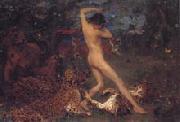 |
John Macallan Swan -- Click Here
|
|
British Academic Painter, 1847-1910
was an English painter and sculptor. John Macallan Swan was born in Brentford, Middlesex in 1847. He received his art training first in England at the Worcester and Lambeth schools of art and the Royal Academy schools, and subsequently in Paris, in the studios of Jean-L??on G??rôme and Emmanuel Fr??miet. He began to exhibit at the Academy in 1878, and was elected associate in 1894 and academician in 1905. He was appointed a member of the Dutch Water-Colour Society in 1885; and associate of the Royal Society of Painters in Water Colours in 1896 and full member in 1899. A master of the oil, water-colour and pastel mediums, an accomplished painter and a skilful draughtsman, he ranks also as a sculptor of distinguished ability. He has treated the human figure with notable power, but it is by his representations of the larger wild animals, mainly the felidae, that he chiefly established his reputation; in this branch of practice he has scarcely a rival. His picture "The Prodigal Son," bought for the Chantrey collection in 1889, is in the National Gallery of British Art. |
|
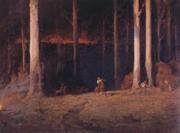 |
John Longstaff -- Click Here
|
|
Australian war artist, 1862-1941 |
|
|
|
|
|
|
|
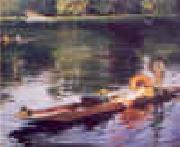 |
John Lavery -- Click Here
|
|
1856-1941
Sir John Lavery (20 March 1856 ?C 10 January 1941) was an Irish painter best known for his portraits.
Belfast-born John Lavery attended the Haldane Academy in Glasgow, Scotland, in the 1870s and the Acad??mie Julian in Paris in the early 1880s. He returned to Glasgow and was associated with the "Glasgow School". In 1888 he was commissioned to paint the state visit of Queen Victoria to the Glasgow International Exhibition. This launched his career as a society painter and he moved to London soon after. In London he became friendly with James McNeill Whistler and was clearly influenced by him.
Like William Orpen, Lavery was appointed an official artist in the First World War. Ill-health, however, prevented him from travelling to the Western Front. A serious car crash during a Zeppelin bombing raid also kept him from fulfilling this role as war artist. He remained in Britain and mostly painted boats, planes and airships. During the war years he was a close friend of the Asquith family and spent time with them at their Sutton Courtenay Thames-side residence, painting their portraits and idyllic pictures like Summer on the River (Hugh Lane Gallery).
After the war he was knighted and in 1921 he was elected to the Royal Academy. During this time, he and his wife both became interested in their Irish heritage and were tangentially involved in both the Irish War of Independence and the Irish Civil War: they gave the use of their London home to the Irish negotiators during the Treaty negotiations. After Michael Collins was killed, Lavery painted Michael Collins, Love of Ireland, now in the Hugh Lane Municipal Gallery.
In 1929 John Lavery made substantial donations of his work to both The Ulster Museum and the Hugh Lane Municipal Gallery and in the 1930s he returned to Ireland. He received honorary degrees from the University of Dublin and Queen's University of Belfast. He was also made a free man of both Dublin and Belfast.
He died in County Kilkenny, aged 84, from natural causes. He was buried in Putney Vale Cemetery. |
|
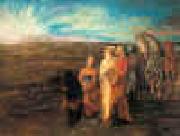 |
John La Farge -- Click Here
|
|
1835-1910
John La Farge (March 31, 1835 ?C November 14, 1910) was an American painter, stained glass window maker, decorator, and writer.
Born in New York City, New York, his interest in art was aroused during his training at Mount St. Mary's University and St. John's College (now Fordham University). He had only the study of law in view until he returned from his first visit to Paris, France where he studied with Thomas Couture and enjoyed the most brilliant literary society of the day. Even his earliest drawings and landscapes, done in Newport, Rhode Island, after his marriage in 1861 to Margaret Mason Perry, sister-in-law of Lilla Cabot Perry, show marked originality, especially in the handling of color values, and also the influence of Japanese art, in the study of which he was a pioneer.
La Farge's inquiring mind led him to experiment with color problems, especially in the medium of stained glass. He succeeded not only in rivaling the gorgeousness of the medieval windows, but in adding new resources by his invention of opalescent glass and his original methods of superimposing and welding his material. Among his many masterpieces are the "Battle Window" at Harvard and the cloisonn?? "Peacock Window" in the Worcester Art Museum. Two of his largest windows are located in Unity Church in North Easton, Massachusetts. The earliest of these, the "Angel of Help" was completed in 1887 while the "Figure of Wisdom" dates to 1901. Both of these windows were restored by "Victor Rothman for Stained Glass Inc" of Yonkers, New York in the 1990's.
Between 1859 and 1870, he illustrated Tennyson's Enoch Arden and Robert Browning's Men and Women. Breadth of observation and structural conception, and a vivid imagination and sense of color are shown by his mural decorations. His first work in mural painting was done in Trinity Church, Boston, in 1873. Then followed his decorations in the Church of the Ascension (the large altarpiece) and St. Paul's Church, New York. For the State Capitol at St. Paul he executed, in his seventy-first year, four great lunettes representing the history of religion, and for the Supreme Court building at Baltimore, a similar series with Justice as the theme. In addition there are his vast numbers of other paintings and water colors, notably those recording his extensive travels in the Orient and South Pacific.
His labors in almost every field of art won for him from the French Government the Cross of the Legion of Honor and membership in the principal artistic societies of America, as well as the presidency of the Society of Mural Painters. Enjoying an extraordinary knowledge of languages (ancient and modern), literature, and art, by his cultured personality and reflective conversation he greatly influenced all who knew him. Though naturally a questioner he venerated the traditions of religious art, and preserved always his Catholic faith and reverence.
In 1904, he was one of the first seven chosen for membership in the American Academy of Arts and Letters. On his passing in 1910, John LaFarge was interred in the Green-Wood Cemetery in Brooklyn, New York. During his life, he maintained a studio at 51 West 10th Street, in Greenwich Village, which today is part of the site of Eugene Lang College |
|
|
|
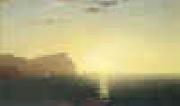 |
John Kensett -- Click Here
|
|
1816-1872
John Kensett Art Galleries
Artist John Frederick Kensett was born on March 22, 1816 in Cheshire, Connecticut, and died on December 14, 1872 in New York City. He attended school at Cheshire Academy, and studied engraving with his immigrant father, Thomas Kensett, and later with his uncle, Alfred Dagget. He worked as engraver in the New Haven area until about 1838, after which he went to work as a bank note engraver in New York City.
In 1840, along with Asher Durand and John William Casilear, Kensett traveled to Europe in order to study painting. There he met and traveled with Benjamin Champney. The two sketched and painted throughout Europe, refining their talents. During this period, Kensett developed an appreciation and affinity for 17th century Dutch landscape painting. Kensett and Champney returned to the United States in 1847.
After establishing his studio and settling in New York, Kensett traveled extensively throughout the Northeast and the Colorado Rockies as well as making several trips back to Europe.
Kensett is best known for his landscape of upstate New York and New England and seascapes of coastal New Jersey, Long Island and New England. He is most closely associated with the so-called "second generation" of the Hudson River School. Along with Sanford Robinson Gifford, Fitz Hugh Lane, Jasper Francis Cropsey, Martin Johnson Heade and others, the works of the "Luminists," as they came to be known, were characterized by unselfconscious, nearly invisible brushstrokes used to convey the qualities and effects of atmospheric light. It could be considered the spiritual, if not stylistic, cousin to Impressionism. Such spiritualism stemmed from Transcendentalist philosophies of sublime nature and contemplation bringing one closer to a spiritual truth.
In 1851 Kensett painted a monumental canvas of Mount Washington that has become an icon of White Mountain art. Mount Washington from the Valley of Conway was purchased by the American Art Union, made into an engraving by James Smillie, and distributed to 13,000 Art Union subscribers throughout the country. Other artists painted copies of this scene from the print. Currier and Ives published a similar print in about 1860. This single painting by Kensett helped to popularize the White Mountain region of New Hampshire.
Kensett's style evolved gradually, from the traditional Hudson River School manner in the 1850s into the more refined Luminist style in his later years. By the early 1870s Kensett was spending considerable time at his home on Contentment Island, on Long Island Sound near Darien, Connecticut. |
|
|
|
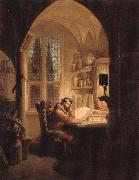 |
john keats -- Click Here
|
|
Born: 31 October 1795
Birthplace: Near London, England
Died: 23 February 1821 (tuberculosis)
Best Known As: Romantic poet who wrote "Ode to a Nightingale"
|
|
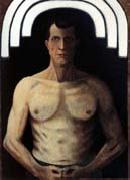 |
John Kane -- Click Here
|
|
1860-1934
American painter of Scottish birth. In 1879 Kane emigrated to western Pennsylvania. He worked as a bricklayer, coal miner, steel worker and carpenter in the Ohio River valley and, in 1890, began to sketch local scenery. After losing his leg in a train accident in 1891, he was employed painting railway carriages. When his son died in 1904, Kane left his family and spent years wandering and working in odd jobs; his earliest surviving paintings date from around 1910. Settling in Pittsburgh, he worked as a house painter and in his spare time painted portraits, religious subjects, the city's urban landscape and memories of his Scottish childhood. In 1927 the jury of the Carnegie International Exhibition, Pittsburgh, encouraged by the painter-juror Andrew Dasburg (b 1887), accepted Kane's Scene in the Scottish Highlands (1927; Pittsburgh, PA, Carnegie Mus. A.). Kane's success, at first considered a hoax by the press, was based on the modernist interest in primitive and folk art. His work was regarded as non-academic and boldly original, and he became the first contemporary American folk artist to be recognized by a museum. Larimer Avenue Bridge (1932; Pittsburgh, PA, Carnegie Mus. A.) is characteristic of his style with its meticulous detail, flat colour and dominant green and red. Though he sketched and painted on the site, Kane freely transposed pictorial elements to create a more pleasing composition. This innate compositional sense is evident in his Self-portrait (1929; New York, MOMA). |
|
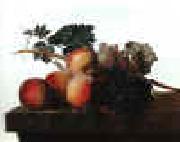 |
John Johnston -- Click Here
|
|
1753-1818
John Johnston Gallery |
|
|
|
|
| | |
|
|
|
|